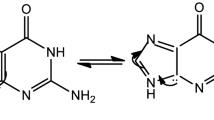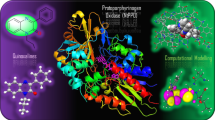Abstract
Mixed-ligand Cu(II), Ni(II), Co(II), and Zn(II) complexes using a tryptophan-derived Schiff base (obtained by the condensation of tryptophan and benzaldehyde) as the primary ligand and 1,10-phenanthroline as the co-ligand were synthesized and characterized analytically and spectroscopically by performing elemental analyses, magnetic susceptibility and molar conductance measurements, UV-Vis, IR, NMR, and FAB-MS. The binding properties of metal complexes with DNA were investigated by electronic absorption spectroscopy, cyclic voltammetry, and by performing viscosity measurements, and the results showed that these complexes have the ability to interact with DNA via an intercalative mode. The DNA cleavage efficiencies of these complexes with pUC19 DNA were investigated by gel electrophoresis. The complexes were found to promote the cleavage of pUC19 DNA from the supercoiled form I to the open circular form II and the linear form III in the presence of ascorbic acid. Finally, the in vitro antibacterial activities of the Schiff base and its mixed-ligand metal complexes were screened against the bacteria Staphylococcus aureus, Bacillus subtilis, Pseudomonas aeruginosa, Escherichia coli, and Salmonella typhi. The antibacterial screening data revealed that the complexes show growth inhibitory activity against bacteria.
Graphical abstract







Similar content being viewed by others
References
Jain S, Longia S, Ramnani VK (2009) People’s J Sci Res 2:37
Berthon G, Blais MJ, Piktas M, Houngbossa K (1984) J Inorg Biochem 20:113
Kiss T, Gergely A (1985) J Inorg Biochem 25:247
Hinojosa M, Ortiz R, Perello L, Borras J (1987) J Inorg Biochem 29:119
Manjul V, Chakraborty D, Bhattacharya PK (1990) Indian J Chem A 29:577
Chakraborty D, Bhattacharya PK (1990) J Inorg Biochem 39:1
Padmavathi M, Satyanarayana S (1997) Indian J Chem A 36:1001
Ceakor S, Biceer E, Ceakor O (2000) Electrochem Commun 2:124
Lau S, Sarkar B (1975) Can J Chem 53:710
Shahabadi N, Kashanian S, Darabi F (2010) Eur J Med Chem 45:4239
Xiong Y, Ji LN (1999) Coord Chem Rev 185:711
Sigman DS, Mazumder A, Perrin DM (1993) Chem Rev 93:2295
Boon EM, Barton JK, Pradeepkumar PI, Isaksson J, Petit C, Chattopadhyaya J (2002) Angew Chem Int Ed 41:3402
Metcalfe C, Thomas JA (2003) Chem Soc Rev 32:215
Sathyaraj G, Weyhermuller T, Unni Nair B (2010) Eur J Med Chem 45:284
Kaur S, Modi NH, Panda D, Roy N (2010) Eur J Med Chem 45:4209
Raman N, Sobha S, Thamaraichelvan A (2011) Spectrochim Acta Part A 78:888
Raman N, Thalamuthu S, Dhaveethuraja J, Neelakandan MA, Banerjee S (2008) J Chil Chem Soc 53:1439
Colak A, Terzi U, Col M, Karaoglu SA, Karabocek S, Kucukdumlu A, Ayaz FA (2010) Eur J Med Chem 45:5169
Lepecp JB, Paoletti C (1967) J Mol Biol 27:87
Satyanarayana S, Dabrowiak JC, Chaires JB (1993) Biochemistry 32:2573
Ni Y, Lin D, Kokat S (2006) Anal Biochem 352:23
Cheng K, Zheng Q-Z, Hou J, Zhou Y, Liu C-H, Zhao J, Zhu H-L (2010) Bioorg Med Chem 18:2447
Ramesh R, Maheswaran S (2003) J Inorg Biochem 96:457
Marmur J (1961) J Mol Biol 3:208
Wolfe A, Shimer GH, Meehan T (1987) Biochemistry 26:6392
Acknowledgments
The authors express their sincere thanks to the College Managing Board, the Principal, and the Head of the Department of Chemistry, VHNSN College, Virudhunagar, India for providing the necessary research facilities. NR thanks the University Grants Commission (UGC), New Delhi for financial assistance.
Author information
Authors and Affiliations
Corresponding author
Rights and permissions
About this article
Cite this article
Raman, N., Sobha, S. & Selvaganapathy, M. Probing the DNA-binding behavior of tryptophan incorporating mixed-ligand complexes. Monatsh Chem 143, 1487–1495 (2012). https://doi.org/10.1007/s00706-012-0718-4
Received:
Accepted:
Published:
Issue Date:
DOI: https://doi.org/10.1007/s00706-012-0718-4




